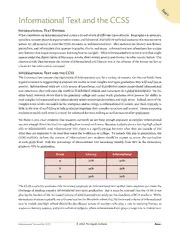
ERIC ED541440: Informational Text and the CCSS PDF
Preview ERIC ED541440: Informational Text and the CCSS
S hi f t Informational Text and the CCSS Informational Text Defined What constitutes an informational text covers a broad swath of different types of texts. Biographies & memoirs, speeches, opinion pieces & argumentative essays, and historical, scientific or technical accounts of a non-narrative nature are all included in what the CCSS envisions as informational text. Also included are literary non-fiction, journalism, and information that appears in graphs, charts, and maps. Informational text oftentimes has unique text features that requires experience learning how to navigate. What informational text is not is text that might appear under the classic rubric of literature: novels, short stories, poetry, and drama—in other words, fiction. The clearest divide then between the realms of informational and literary text is the reliance of the former on fact as a basis for the information conveyed. Informational Text and the CCSS The Common Core stresses the importance of informational text for a variety of reasons. On the one hand, there is good evidence to suggest that if students are unable to read complex text upon graduation they will read less in general. Informational texts are a rich source of knowledge, and if graduates cannot comprehend informational text structures, they will enter the world as ill-informed citizens and consumers in a global marketplace. On the other hand, research shows that to be genuinely college and career ready graduates must possess the ability to read complex informational text independently across numerous disciplines and topic areas. Indeed, most of the complex texts adults encounter in the workplace and in college is informational in nature, and there typically is little in the way of scaffolding to help graduates negotiate their complex structure and content. Hence preparing students to tackle such texts is critical for informed decision making as well as success after graduation. Yet there is also clear evidence that students currently do not have enough exposure to complex informational text nor enough direct instruction regarding how to read such texts. Because students are not leaving high school able to independently read informational text, there is a significant gap between what they are capable of and what they are expected to do once they enter the workforce or college. To remedy this gap in preparation, the CCSS explicitly defines the amount of informational text students should be expose to across the curriculum at each grade level—with the percentage of informational text increasing steadily from 50% in the elementary grades to 70% by graduation. Grade Literary Informational 4 50% 50% 8 45% 55% 12 30% 70% The CCSS explicitly promotes this increased emphasis on informational text so that more students can meet the challenge of reading complex informational text upon graduation. But it must be stressed that the CCSS is not placing the burden of the increased volume of informational text solely on the shoulders of ELA teachers. While elementary students typically are with one teacher for the whole school day, the increased volume of informational text in middle and high school should be distributed across all teachers who play a role in teaching literacy to students—history, science, and even technical subjects, where informational text plays a large role in instruction. Informational Text and the CCSS Page 1
